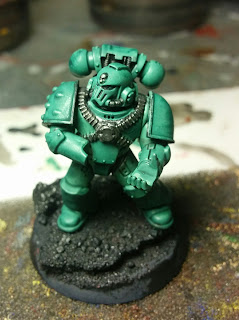Gracias a las experiencias de otros ejércitos tenía claras las siguientes cosas:
- el color base no debía ser mezcla de varios
- el tiempo de pintado tenía que reducirse al máximo manteniendo un resultado bueno
- la paleta tenía que ser reducida
Teniendo esas ideas claras y tras haber leído muchos posts sobre cómo pintar las miniaturas de Herejía me puse manos a la obra.
Color base
Lo primero que hice fue descartar la receta de pintado de Hijos de Horus de Forgeworld, la podeís leer vosotros mismos. Es una locura en la que se mezclan cuatro tipos de verde sólo para la capa base, en este post hay un paso a paso bastante bueno que te explica cómo usar esa receta, pero como se puede ver, es un proceso largo y complejo, aunque el resultado sea bueno.
Seguí buscando recetas de pintado sin éxito ya que la mayoría de la gente usa mezclas, hasta que tuve la suerte de leer este post en el foro de Bolter and Chainsword donde hay unas fotos de unos legionarios con un color verde muy conseguido que decía utilizar simplemente dos colores directamente del bote de Vallejo. Este parecía el candidato adecuado, me compré los dos botes, hice unas pruebas de color y la verdad que me convencieron, ahora podeís juzgarlo vosotros.
Como inspiración he utilizado también este blog en el que va escribiendo artículos a medida que pinta su ejército y en estas fotos de Warhammer World en el que se ven legionarios suficientemente de cerca para apreciar todos los detalles.
Paleta
Como he dicho antes, la paleta tiene que ser reducida. Para un ejército numeroso ayuda a la cohesión y especialmente en este caso en el que hay muchas pequeñas conversiones no quiero dar un aspecto caótico, sino el de un ejército curtido en batallas, con veteranos y en mitad de una campaña.
Por lo tanto la paleta se reduce a lo siguiente.
- Para los grises: German Grey Model Color, Wolf Grey de Army Painter, Wolf Grey Game Color y Bonewhite Game Color.
- Metálicos con Gunmetal Model Color y Silver Game Color.
- Tintas y sombras con Coelia Greenshade Citadel y Dark Tone de Army Painter.
- Verdes con USMC Tank Crew Panzer Aces y USMC Highlight Panzer Aces.
- Rojos con Parasite Brown Game Color, Plague Brown Game Color y Mephiston Red Citadel.
 |
| Grises |
 |
| Metálicos |
 |
| Tintas |
 |
| Verdes |
 |
| Rojos |
Receta
La receta de pintado es sencilla, hay que tener en cuenta que tengo que pintar unos 80 legionarios, asi que no podía hacer muchas florituras. Es por eso también que descarté utilizar NMM, ya que no sabría bien cómo aplicarlo a tanques y Dreadnoughts.
- Capa base negra
- Gunmetal para los metálicos
- USMC Tank Crew para los verdes
- German Grey en la peana
- Capa generosa de Dark Tone en la peana y metálicos
- Lavado con Coelia Greenshade en la armadura
- Pintar la peana: pincel seco generoso de Wolf Grey y luego muy ligero de un gris mas claro
- Repasar armadura con USMC Tank Crew
- Iluminar metálicos con Silver
- Pintar detalles: ojos, granadas, etc...
- Iluminar armadura con USMC Highlight
- Pintar símbolo de Horus
- Aplicar desgastes: desconchones, marcas de óxido
- Pigmentos en peana y piernas
- Barnizar en mate
Todo este proceso me llevó unas 3 horas aproximadamente partiendo de la miniatura ya imprimada. Creo que puedo rebajarlo cuando pinte en cadena, lo siguiente que tengo en la lista son 14 legionarios de la misma escuadra así que pronto se podrá comprobar.
A continuación os enseño las fotos incluyendo pasos intermedios, están hechas con el móvil porque haré otra ronda de fotos en la caja de luces mas adelante con el resto de la escuadra.
 |
| Miniatura recién montada (es diferente de la que pinté finalmente, no me di cuenta y no le hice foto antes de imprimar). En la peana he usado Oxid Paste como con mis skavens. |
 |
| Estado de la figura en el paso #3 |
 |
| Estado de la figura en el paso #6, con el lavado recién aplicado |
 |
| Estado de la figura tras dejar secar el lavado del #5 y #6, se aprecia que el tono de verde ha bajado un punto. |
 |
| Estado de la figura tras el paso #12 |
 |
| Resultado final |
Notas finales
Se puede comprobar que el resultado final no es espectacular pero cumple para tabletop.
Hay bastantes cosas a mejorar pero estoy razonablemente sastisfecho para ser la primera. Me he dado cuenta que el lavado en el paso #6 fue demasiado generoso asi que lo tendré que diluir un poco.
Adicionalmente los ojos se ven demasiado apagados asi que tendré que trabajarlos mas y los desconchones en algunos casos son muy pobres o con trazos muy gruesos asi que me tocará seguir mejorando.
Pintado en 2016.
¡Espero vuestras opiniones!











